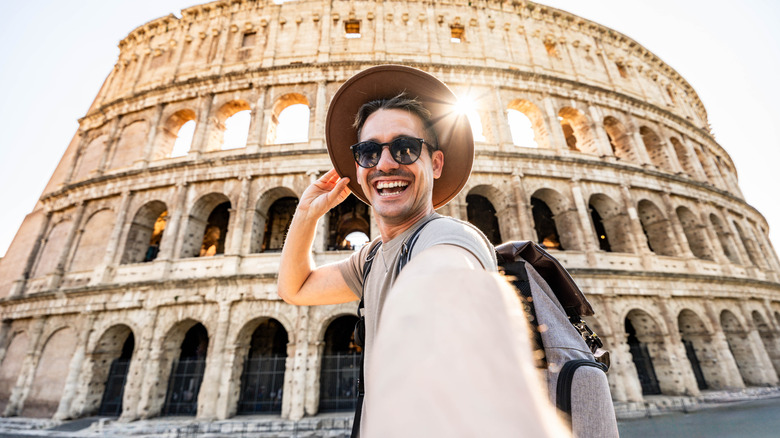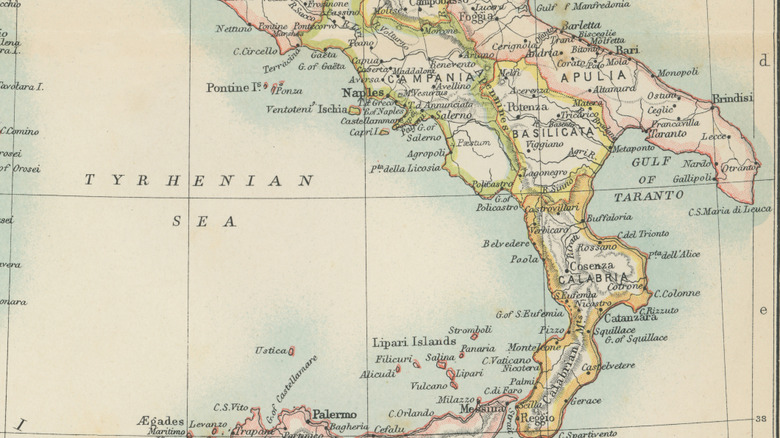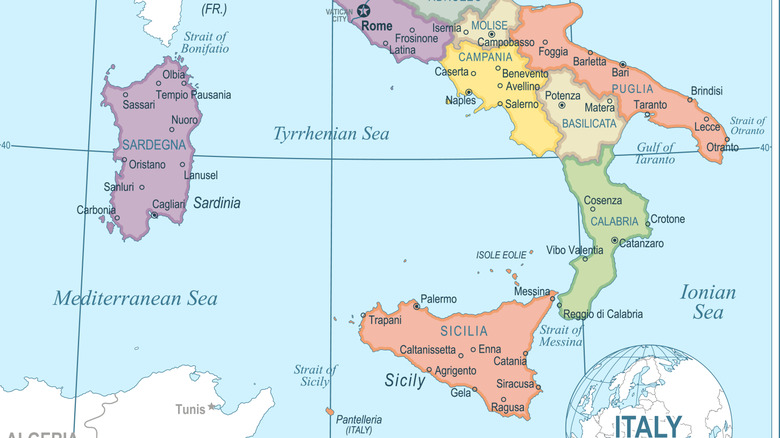The Only Map Of Italy You Need For Your Upcoming Trip
With a variety of places to tempt every travel palate, Italy is the destination dream for countless travelers. This founding member of the European Union covers more than 116,000 square miles and offers views of the Mediterranean coast, soaring mountains, and historic buildings. It's a lot to explore, and as they say, location is everything.
Each summer, tourists flock to Italy, making the warmest months the most crowded and most expensive time to visit. Book accommodations early for your summertime travel to the country and expect crowds, especially at the beaches. May to September is considered the high season for a reason. Typically, spring and autumn offer lower temperatures, less-expensive accommodations, and fewer people. That means the lines to see historic attractions are shorter, making them more accessible. December to February is the low season, and tourists willing to face chillier weather will find plenty of space to explore at their leisure. But where, exactly, should one visit in Italy? Every corner of this historic country has something to offer if you know where to look.
Northern Italy: Explore romance, cathedrals, and mountain views
Stretching more than 350,000 acres across Italy's northern border, the stunning Dolomites are a worldwide attraction. In the summer, tourists flock to hike its many trails and catch a glimpse of the Tre Cime di Lavaredo, or the Three Peaks of Lavaredo. Arguably the most popular peaks of the mountain range, these mountains are suitable for hikers of all skill levels, and guides for day trips or even overnight excursions are available. Consider booking a stay in the charming authentic village of San Vigilio di Marebbe, considered a gateway to adventure in the Dolomites.
The range is also easily accessible from nearby Venice. The "floating city" of canals is often described as one of Europe's most romantic destinations and offers attractions to fill any vacationer's itinerary for days. The Basilica of St. Mark is the center of religious and public life in Venice and still offers religious services. The Basilica is free to enter for self-tours, but booking a paid, guided tour can help guests avoid the long lines at the entrance. Despite being an essential stop, it is important to know that Venice is world renown, meaning it's also at risk of being one of many sites facing the danger of overtourism.
A three-hour train or car ride west of Venice will take guests to Milan, Italy's financial hub and one of the world's fashion and design capitals. Arguably the most iconic site here is the Duomo of Milan, a cathedral that was constructed over five centuries and is still used today. Guided tours are available and offer views of carved statues, paintings of religious events, and glimpses of the skeletons of saints still wearing their finest clothes.
Central Italy: historic sites and Renaissance art
Resting near the middle of the boot-shaped country is Rome, the country's capital, most populous city, and home to the country's busiest international airport. Nestled within it is Vatican City, an independent country and home to the Roman Catholic Church. For this reason, Rome is often called the capital of two states. Sites to visit can fill pages of a vacation schedule and should include the Colosseum, Sistine Chapel, Vatican Museum, and St. Peter's Basilica. While here, consider renting a segway, one underrated way to explore most of Rome while saving your legs. The popularity of these attractions means securing tickets early is key and tourist cards like the Rome City Pass likely offer the best prices to see the most sites.
Resting on central Italy's west coast is one of the most photographed buildings in the world. The Leaning Tower of Pisa, which was built as a bell tower for the nearby cathedral and began its famous tilt in the 12th century. There's more to the area than just the famous tower, however. Guests can tour the nearby Square of Miracles, the Cathedral of Santa Maria Assunta, and the Pisa Botanical Garden, which is one of the oldest university botanical gardens in the world.
History is everywhere in Italy, and one of the most famous and recognizable pieces of Renaissance Art is displayed in the Accademia Gallery in Florence. Michelangelo's David has stood here since 1872, when it was moved indoors for its own protection. The Leonardo DaVinci Interactive Museum is also in Florence, giving visitors a look at replicas of the machines he envisioned in the 15th century.
Southern Italy: the Amalfi Coast, Pompeii, and historical homes
A quick two-hour train ride from Rome will bring tourists to the famous archaeological site of Pompeii in Southern Italy. Public transportation throughout the country makes it easy to avoid the mistake of renting a car during your trip. The ancient city of Pompeii is one of the largest archeological sites in Europe and was destroyed during the eruption of Mount Vesuvius in 79 A.D. Half an hour away on the other side of Vesuvius you'll find the port city of Naples, where travelers gain easy access to food, shopping, and more historic sites. The Royal Palace of Caserta sits just outside of Naples to the north and offers visitors a glimpse of 18th century Italian royalty. Nearby, the Vanvitelli Aqueduct serves the palace as well as its fountains and gardens, which are accessible to tourists today.
Travelers looking for sun and sand to mix in with their historic views can go to the Amalfi Coast, which stretches for 34 miles. These villages along the coastal waters of the Mediterranean offer ample options for scenic hiking views. There are many villages to choose from on the Amalfi Coast including the popular destinations of Positano, Amalfi, and Ravello. If you'd like to get away from the crowds, you can also try smaller villages like Conca dei Marini or Praiano.
Further south, just above the country's "boot heel," is the small village of Albelobello. Here, time slows down and visitors can explore the Trulli, which are small, historical houses with conical roofs. Tours of these drystone homes that date back to the 14th century are a great way to learn about the aristocratic past of this rural area while celebrating the residents who still live here. It's no surprise that Albelobello is a UNESCO World Heritage site.
Italy's Islands: Sun, sand, and sea
It's no wonder Italy considers its islands to be one region — there are, after all, 450 of them. The best known is the large island of Sicily. There, tourists flock to Agrigento, home to the UNESCO World Heritage Site Valley of the Temples. Ancient Greek buildings dating back more than two millennia are preserved here and show the culture's devotion to Greek gods. The active volcano Mount Edna, Europe's largest, provides hiking opportunities and spectacular views of the sea.
Italy's second largest island, and also among the most familiar, is Sardinia, which sits in the middle of the Mediterranean. Several different international airports offer flights here and a ferry transports locals and tourists alike via a five-hour ride from Rome. While Sardinia has plenty of hotels and restaurants, it's often seen as "less Italian" than most of Italy because of its location, more ancient traditions, and the large number of indigenous plants and animals that are found here.
Just over 60 miles off the coast of Rome, six tiny islands make up the Pontines. Only two of the six islands are inhabited, making them a striking example of untouched nature in the Mediterranean. Here, tourists visit in the spring and summer, using the convenient ferries that make the journey from the mainland in just a couple of hours.




